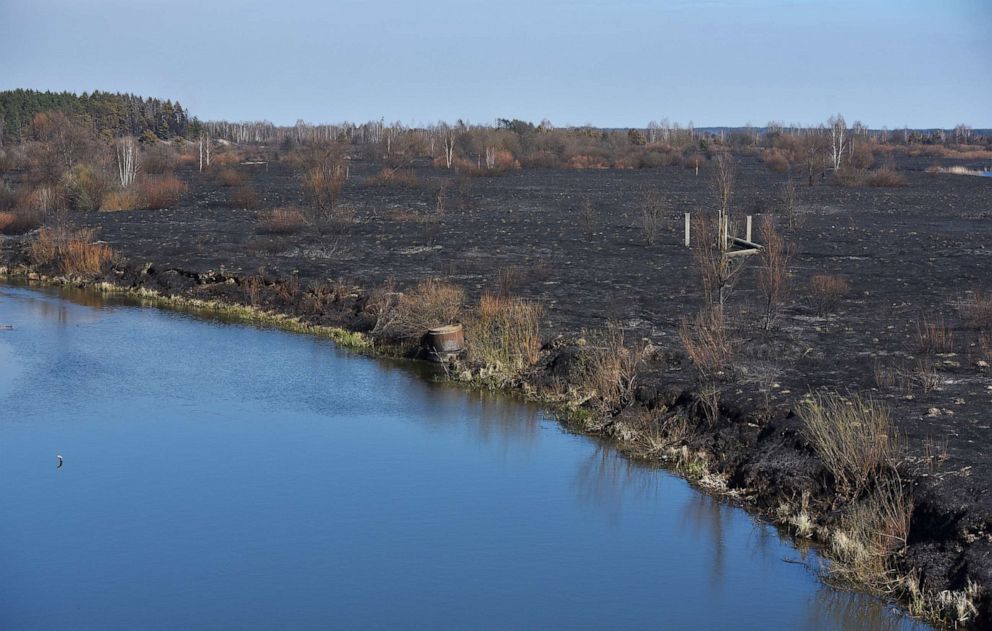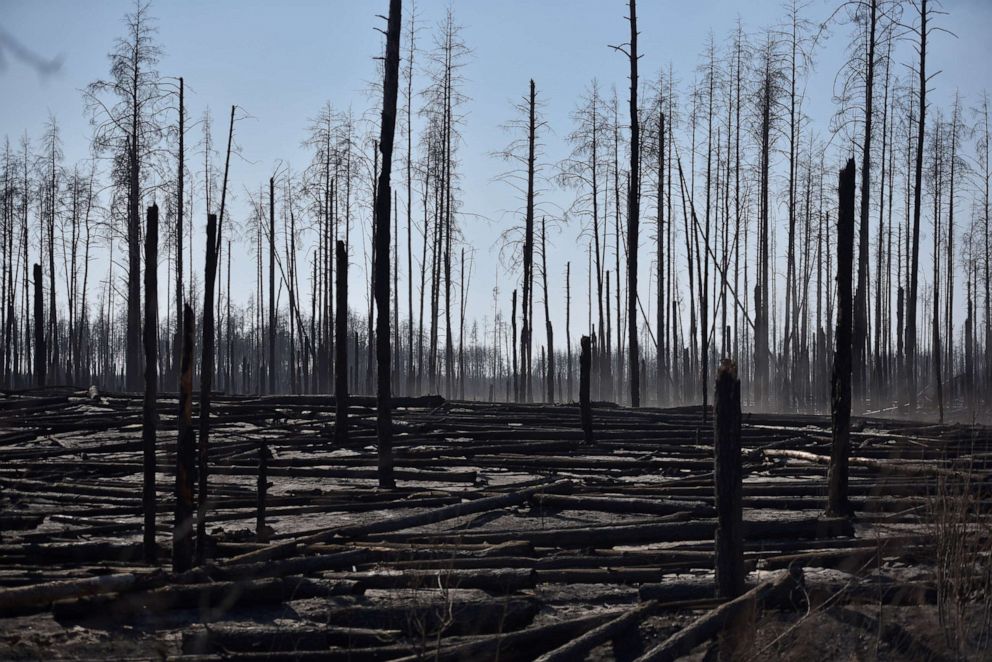Ukraine says wildfires close to Chernobyl are extinguished after rain falls
The fires had come within a mile of the former nuclear power station on Monday.
Officials in Ukraine said wildfires close to the former Chernobyl nuclear power station have now stopped burning after rain fell in the area on Tuesday.
Firefighters had been struggling to control the wildfires inside the 18-mile Exclusion Zone that surrounds the power station for 10 days. On Monday the fires had come within a mile of the station itself, with local guides warning they were out of control.
But rain on Tuesday morning allowed the firefighters to gain the upper hand and by the afternoon the office of Ukraine’s president, Volodymyr Zelenskiy, said the fires were no longer burning.
In a statement, Zelenskiy’s office said he had been briefed by the chief of the state emergency service, Mykola Chechotkin, who said there was already no open flames in the Exclusion Zone. Chechotkin said that firefighters would now need a “few more days” to put out the ground which was still smoldering.

The head of Ukraine’s ecological inspection service, Yegor Firsov, who said he was inside the Exclusion Zone, confirmed that the fires were now out.
"In short - they have managed to extinguish the fire, the rain helped a lot,” Firsov wrote on his Facebook page. “The level of radiation background is constantly being measured, but based on the data that we have, on the whole everything is within the norm,” he wrote on Facebook. “We need to say a big thank to the firefighters who fought the fire for 10 days."
Around 500 firefighters had been trying to extinguish the fires, backed by a hundred vehicles, including three helicopters and three planes, according to the state emergency service.
The fires around Chernobyl have prompted fears about radiation, in particular in Ukraine’s capital Kyiv, which is 60 miles south. But authorities have said that while radiation levels at the heart of the fire had raised slightly, they remained close to normal and that further away, including in Kyiv and its surroundings, the levels had not risen.
Ukraine’s authorities have sought to show they have the situation under control after a group that offer tours to Chernobyl a day earlier accused the government of concealing the severity of the problem and warned much of the site around the power station was at risk of destruction.
Yaroslav Yemelianenko, the head of the Association of Chernobyl Tour Operators, who also works with the state agency overseeing the Exclusion Zone, on Monday warned the fire had come within a mile of the power station itself and just over a mile from a radioactive waste storage facility. He provided video from Monday night showing thick smoke swirling around the approaches to station.

Yemelianenko and other guides warned that the ghost city, Pripyat, abandoned following the 1986 accident at the station, had also been at risk of burning. Fires had also been reported burning inside the "Red Forest," an area of woodland where fallout landed from the accident, swiftly killing the trees that left them an eerie red color.
Strong winds on Monday had made the fires particularly severe. Chechotkin, the emergency service head, said firefighting aircraft had flown 227 flights and dumped 500 tonnes of water on Monday to contain the fires and had succeeded in preventing them from spreading to power stations or any of the dangerous sites around it.
Wildfires around Chernobyl are common and have happened in the last several years. But this year’s fires have been the worst recorded, the product of an exceptionally dry winter that saw almost no snow.
“This is the biggest fire in the history of the Chernobyl Exclusion Zone,” Yemelianenko told ABC News by phone on Monday. He and other guides traveled to the Zone on Tuesday to deliver drinking water and generators to firefighters there.
Radiation levels within the Zone are generally not above normal—most of the highly radioactive material has been buried and absorbed by vegetation and into the area’s water cycle. The fire though releases some radioactive particles as it burns contaminated vegetation and there had been worries that smoke carrying them might be inhaled although authorities said there was no danger in Kyiv or its surroundings.
The destroyed reactor that exploded in April 1986 is now sealed under a giant metal and concrete shell. The power station’s three surviving reactors were shutdown in 2000.
The guides said while radiation was a worry, their main fear, however, had been that the fires were destroying Chernobyl and the unique historical landscape and natural environment within the Exclusion Zone. The disaster site has become a popular destination for tourists, who take organized tours around Pripyat and parts of the station, and the industry has boomed since the hit HBO mini-series "Chernobyl" aired last year.
The Exclusion Zone also now resembles a nature reserve despite the radioactive contamination, as the absence of humans has seen nature return, with species all but vanished in other parts of Europe re-appearing. Olena Gnes, a guide at Yemelianenko’s company, Chernobyl Tour, said the fires had been destroying that habitat.
"The concentration of the radionuclides in the atmosphere it will not be really critical, like dangerous for health," Gnes said by phone Monday. "The biggest concern is that we are losing our heritage. It's one of the biggest natural reserves in the whole Europe. So it is a big tragedy that this nature is now being so damaged. It's awful."
Some sites of the Exclusion Zone had already been destroyed. Dmitry Shibalov, a tour guide, posted a video on Monday he said he had filmed of another abandoned town where he said most of the buildings had been burnt to the ground.
Police have blamed the fires on people living close to the Exclusion Zone burning grass. A 27-year-old local man was arrested last week and police on Monday evening said they had detained another 37-year-old man, both suspected of causing the fires by burning brush nearby.
Ukraine’s parliament on Monday passed a law in an emergency session that steeply increases fines for illegally burning plant material and causing air pollution and damage, upping the maximum penalties from a few hundred dollars to several thousand dollars.



